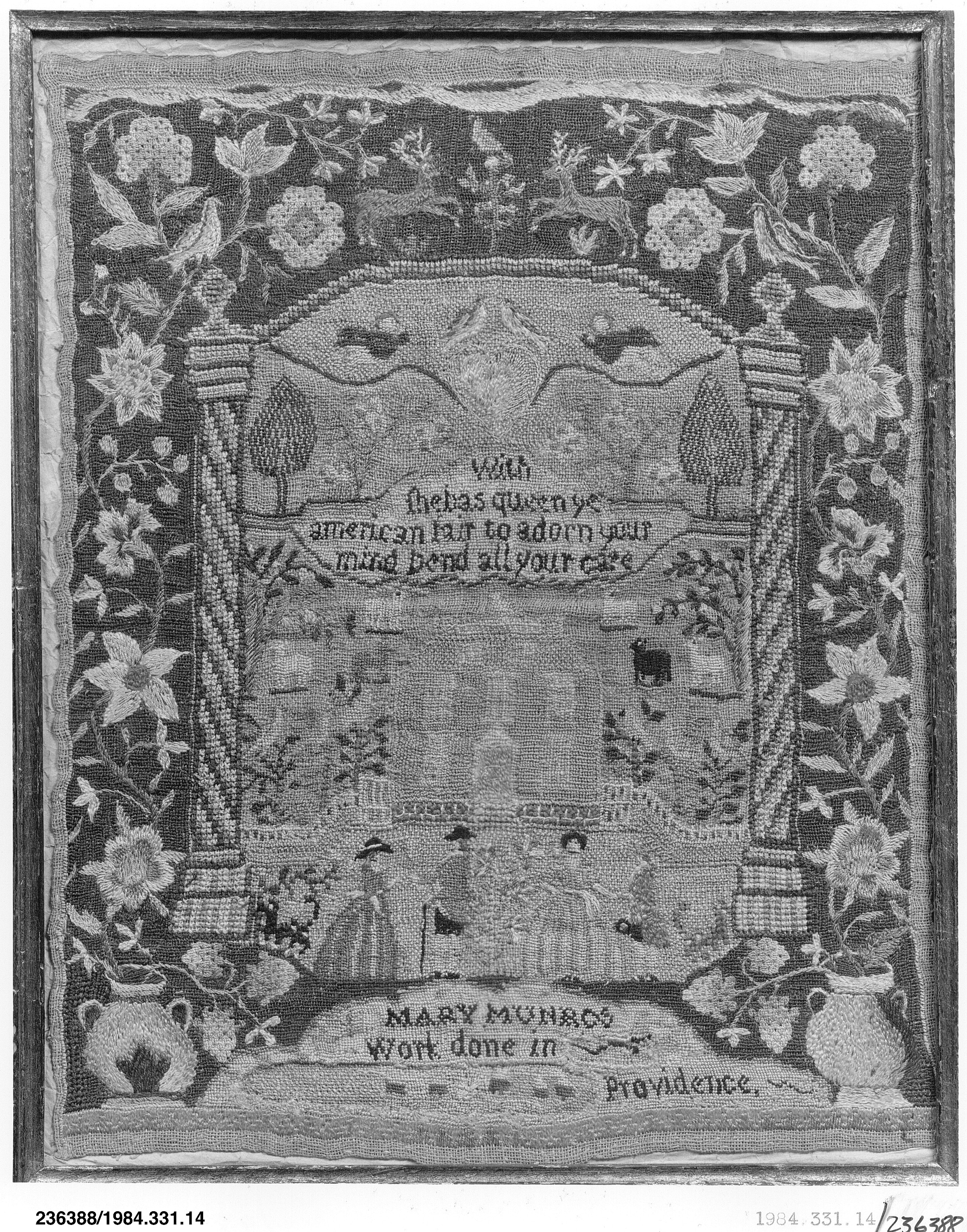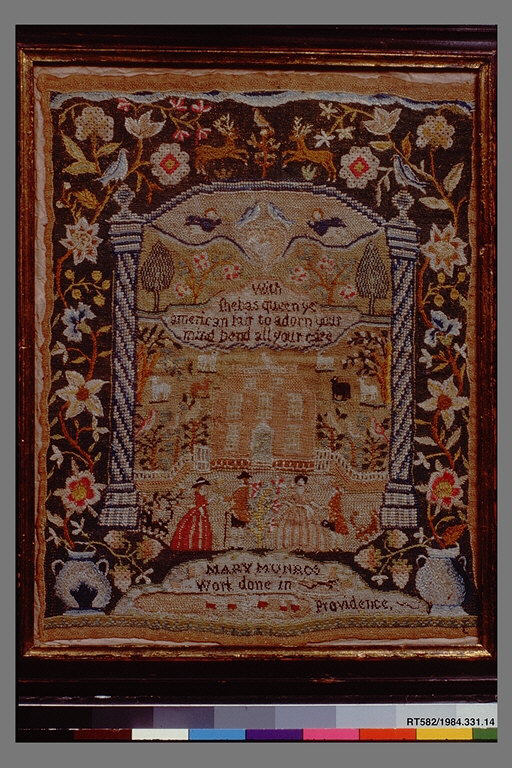Sampler
Mary Munro American
Mary Munro made this sampler at Mary Balch’s school, the best-known girls’ boarding and day school in Providence, Rhode Island. Established in 1785, by Sarah Roger Balch (1735-1811) and her daughter, Mary Balch (1762-1831) the school remained active for forty-two years until 1847/8. Mary Balch taught until the 1820s when her step daughter, Elizabeth Walker (ca. 1783-1865), took over, guiding the prestigious school until it closed. Although the Balch’s school is not named in any of the samplers that were made there, many have "Providence," stitched near the maker’s name as seen in the bottom of Mary’s sampler. The Balch school educated students between the ages of six and twenty.
This carefully stitched sampler displays an overall design of floral motifs, elegant men and women in eighteenth-century dress, grazing animals, and built structures. It is typical of the earliest samplers to survive from the Balch school. Worked in a variety of stitches, Mary’s border consists of richly colored meandering floral vines emanating from large two-handled urns on a dark green background. The two striped blue columns enclose the multi-tiered center of the sampler. At the top register two stags prance over a flattened arch below which a pair of birds perch on a heart, flanked by trumpeting angels--a design detail characteristic of Balch school samplers.
The central motif of the sampler is Providence’s State House. This three-bay brick building with a hipped roof, balustrade and central tower is where Rhode Island renounced allegiance to the British Crown on May 4, 1776, the first of the thirteen colonies to do so. The idea of featuring real buildings on samplers is typical of early Balch school samplers; and several other important Providence public buildings -- the Court House, the College of Rhode Island (now University Hall of Brown University), the First Baptist Meeting House and the First Congregational Church—were featured in the school’s samplers as the central motif.
Below Mary’s rendition of the State House are two sets of elegantly dressed male-female courting couples. Flowering trees, animals and birds fill the spaces between the major design features. Taken together Mary’s composition and decorative devices are rich in allusions to nature, courtship, and the values of the new republic. Mary and her classmates were the first generation of women to live in the newly independent United States of America. These post-Revolutionary women were considered an important influence on educating the future leaders of the new country in a role known as "Republican Motherhood."
When Mary Munroe attended Mary Balch’s school it was in a rented house at the foot of Constitution Hill in close proximity to the thriving commercial center of Providence. Nearby was Todds’s bookstore and the printing, binding, and bookselling firm operated by John Carter, editor of the Providence Gazette, whose daughter, Rebecca, also made a sampler at the Balch school. (American Folk Art Museum, New York City, 2013.1.47).
The Met Museum has another Balch school sampler made by Mary’s first cousin, Rebekah Munro (1984.331.13). Both Mary’s and Rebekah’s samplers contain the stitched maxim: "With Sheba’s queen ye American fair. To adorn your mind, bend all your care." This refers to the growing expectation toward the end of the eighteenth century that celebrated schools like Mary Balch’s taught not only sewing, music, dancing and drawing, but also reading, grammar, writing, arithmetic, geography and history.
Mary Munro was the second child of Thomas Munro (c. 1736-1815) and Sarah Nightingale Munro (1744-1830) of Providence. Her father was a privateer shipping captain who often worked with his wife’s brother Joseph Nightingale in the merchant partnership Clark & Nightingale, trading New England goods in the Caribbean. Mary’s grandfather, Samuel Nightingale 1715-1789) was a graduate of Harvard College, owned a distillery, invested in mercantile ventures related to the triangle trade and later served as a Justice of the Peace and as an associate Justice of the Rhode Island Supreme Court. Nothing yet has been discovered about Mary’s life as an adult, making her sampler the single record of her life, which might otherwise have been lost in history.
Due to rights restrictions, this image cannot be enlarged, viewed at full screen, or downloaded.
This artwork is meant to be viewed from right to left. Scroll left to view more.




